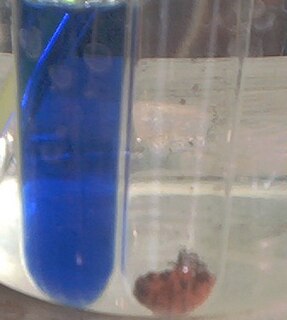Related Research Articles

In chemistry, an aldehyde is an organic compound containing a functional group with the structure −C(H)=O. The functional group itself is known as an aldehyde or formyl group. Aldehydes are common and play important roles in the technology and biological spheres.
Benedict's reagent is a chemical reagent and complex mixture of sodium carbonate, sodium citrate, and copper(II) sulfate pentahydrate. It is often used in place of Fehling's solution to detect the presence of reducing sugars. The presence of other reducing substances also gives a positive result. Such tests that use this reagent are called the Benedict's tests. A positive test with Benedict's reagent is shown by a color change from clear blue to brick-red with a precipitate.
Marquis reagent is used as a simple spot-test to presumptively identify alkaloids as well as other compounds. It is composed of a mixture of formaldehyde and concentrated sulfuric acid, which is dripped onto the substance being tested. The United States Department of Justice method for producing the reagent is the addition of 100 mL of concentrated (95–98%) sulfuric acid to 5 mL of 40% formaldehyde. Different compounds produce different color reactions. Methanol may be added to slow down the reaction process to allow better observation of the colour change.

Fehling's solution is a chemical reagent used to differentiate between water-soluble carbohydrate and ketone functional groups, and as a test for reducing sugars and non-reducing sugars, supplementary to the Tollens' reagent test. The test was developed by German chemist Hermann von Fehling in 1849.

A reducing sugar is any sugar that is capable of acting as a reducing agent. In an alkaline solution, a reducing sugar forms some aldehyde or ketone, which allows it to act as a reducing agent, for example in Benedict's reagent. In such a reaction, the sugar becomes a carboxylic acid.
In chemistry, a chemical test is a qualitative or quantitative procedure designed to identify, quantify, or characterise a chemical compound or chemical group.
Reductive amination is a form of amination that involves the conversion of a carbonyl group to an amine via an intermediate imine. The carbonyl group is most commonly a ketone or an aldehyde. It is considered the most important way to make amines, and a majority of amines made in the pharmaceutical industry are made this way.

The Schiff test is an early organic chemistry named reaction developed by Hugo Schiff, and is a relatively general chemical test for detection of many organic aldehydes that has also found use in the staining of biological tissues. The Schiff reagent is the reaction product of a dye formulation such as fuchsin and sodium bisulfite; pararosaniline and new fuchsin are not dye alternatives with comparable detection chemistry.
Enlighten Harm Reduction is an organisation based in Melbourne, Victoria, Australia, dedicated to informing drug users about which chemicals are in their drugs by using various tests. Before attracting heavy amounts of legal and political attention, Enlighten was present at many of the major dance events in Australia, providing facilities for drug users to test their pills for their contained chemicals.

Reagent testing is one of the processes used to identify substances contained within a pill, usually illicit substances. With the increased prevalence of drugs being available in their pure forms, the terms "drug checking" or "pill testing" may also be used, although these terms usually refer to testing with a wider variety of techniques covered by drug checking.

Folin's reagent or sodium 1,2-naphthoquinone-4-sulfonate is a chemical reagent used as a derivatizing agent to measure levels of amines and amino acids. The reagent reacts with them in alkaline solution to produce a fluorescent material that can be easily detected.
para-Dimethylaminobenzaldehyde is an organic compound containing amine and aldehyde moieties which is used in Ehrlich's reagent and Kovac's reagent to test for indoles. The carbonyl group typically reacts with the electron rich 2-position of the indole but may also react at the C-3 or N-1 positions. It may also be used for determination of hydrazine.
The Hinsberg reaction is a test for the detection of primary, secondary and tertiary amines. In this test, the amine is shaken well with Hinsberg reagent in the presence of aqueous alkali. A reagent containing an aqueous sodium hydroxide solution and benzenesulfonyl chloride is added to a substrate. A primary amine will form a soluble sulfonamide salt. Acidification of this salt then precipitates the sulfonamide of the primary amine. A secondary amine in the same reaction will directly form an insoluble sulfonamide. A tertiary amine will not react with the original reagent(benzene sulfonyl chloride) and will remain insoluble. After adding dilute acid this insoluble amine is converted to a soluble ammonium salt. In this way the reaction can distinguish between the three types of amines.
The Liebermann reagent named after Hungarian chemist Leo Liebermann (1852-1926) is used as a simple spot-test to presumptively identify alkaloids as well as other compounds. It is composed of a mixture of potassium nitrite and concentrated sulfuric acid. 1 g of potassium nitrite is used for every 10 mL of sulfuric acid. Potassium nitrite may also be substituted by sodium nitrite. It is used to test for cocaine, morphine, PMA and PMMA.
The Mecke reagent is used as a simple spot-test to presumptively identify alkaloids as well as other compounds. It is composed of a mixture of selenous acid and concentrated sulfuric acid, which is dripped onto the substance being tested.
The Mandelin reagent is used as a simple spot-test to presumptively identify alkaloids as well as other compounds. It is composed of a mixture of ammonium metavanadate and concentrated sulfuric acid. Its primary use is for the detection of ketamine and PMA Unlike the most common reagent test chemicals, it has a very strong yellow colour prior to being reacted with the unknown substance for testing. The colour of the reagent itself forms within about 48 hours of mixing and is important to factor into the colour-change-based testing method, as not all colour tables take care to start Mandelin results from this non-neutral yellow base hue.
The Froehde reagent is used as a simple spot-test to presumptively identify alkaloids, especially opioids, as well as other compounds. It is composed of a mixture of molybdic acid or a molybdate salt dissolved in hot, concentrated sulfuric acid, which is then dripped onto the substance being tested.

Sodium nitroprusside (SNP), sold under the brand name Nitropress among others, is a medication used to lower blood pressure. This may be done if the blood pressure is very high and resulting in symptoms, in certain types of heart failure, and during surgery to decrease bleeding. It is used by continuous injection into a vein. Onset is typically immediate and effects last for up to ten minutes. It does not cause a reflex tachycardia which can be seen in other agents. As a result, it is often used as the vasodilator of choice in acute, emergency situations.
The Zimmermann reagent is used as a simple spot-test used in chromatography to presumptively identify alkaloids, especially benzodiazepines, as well as other compounds. It is therefore used in drugs testing.

The Chen-Kao reaction is a chemical method for determining the presence of Pseudoephedrine, Ephedrine, and similar phenylalkylamines. The reaction is used in spot tests and is also known as Chen-Kao test. The test is often used to distinguish ephedrine, pseudoephedrine, Norephedrine, Cathinone and Methcathinone from Amphetamine and Methamphetamine, which do not react with Chen’s test reagent.
References
- 1 2 3 "Simon's Reagent Testing Kit (Yellow & Green Labels)". Dancesafe. Archived from the original on 2014-02-15. Retrieved 2012-01-30.
- ↑ Thompson, Robert; Thompson, Barbara Fritchman (2012-08-14). Illustrated Guide to Home Forensic Science Experiments: All Lab, No Lecture. "O'Reilly Media, Inc.". p. 255. ISBN 978-1-4493-3451-2.
- 1 2 3 "Chemistry and Reaction Mechanisms of Rapid Tests for Drugs of Abuse and Precursors Chemicals" (PDF). UNODC. Retrieved 2012-01-30.
- 1 2 "Color Test Reagents/Kits for Preliminary Identification of Drugs of Abuse" (PDF). Law Enforcement and Corrections Standards and Testing Program. July 2000. Retrieved 2011-07-24.
- ↑ Leeuwenkamp, O. R.; van Bennekom, W. P.; van der Mark, E. J.; Bult, A. (1984). "Nitroprusside, antihypertensive drug and analytical reagent". Pharmaceutisch Weekblad. 6 (4): 129–140. doi:10.1007/BF01954040. ISSN 0031-6911. PMID 6384923. S2CID 21283981.